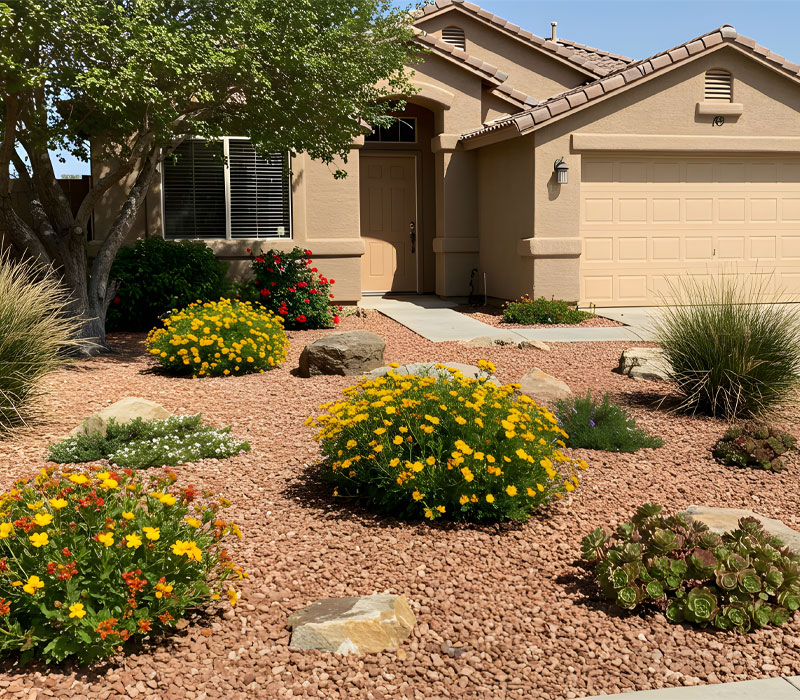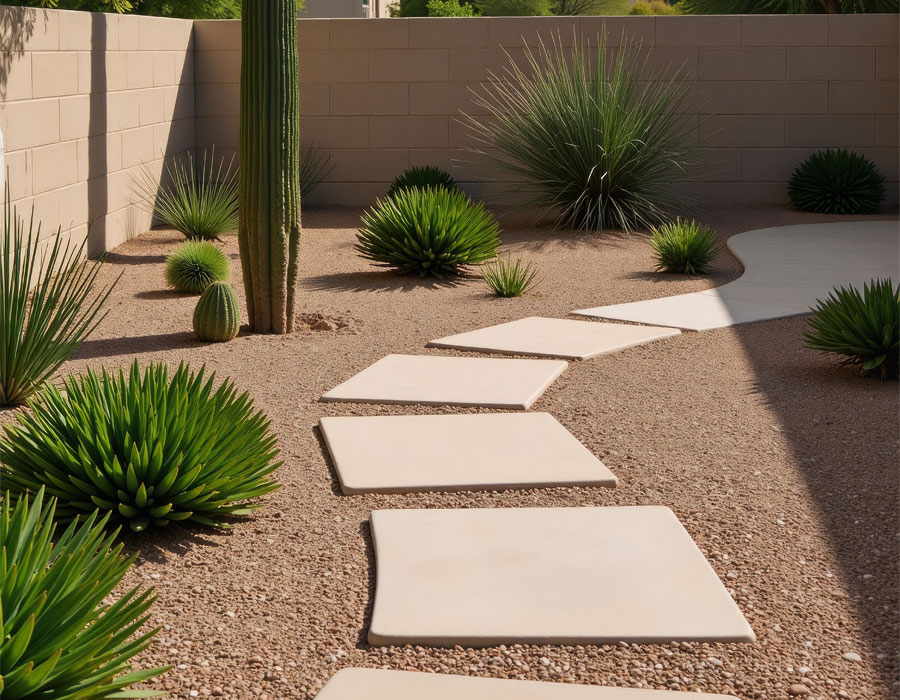decomposed granite patio, decomposed granite pathways, decomposed granite pathway, installation, contractor, installing, install, recycled concrete, construction projects, driveways, construction, pathway, driveway, concrete
Frequently Asked Questions
Who does decomposed granite installation?
Decomposed granite installation is typically performed by professional landscaping companies, like Enviroscape Services, LLC, which specialize in creating functional outdoor spaces tailored to the specific needs of residential properties in Arizona.
What are the benefits of decomposed granite?
The benefits of decomposed granite include its low maintenance requirements, water efficiency, and natural aesthetic appeal, making it an ideal choice for enhancing outdoor spaces in Arizona's desert environment.
How is decomposed granite installed?
The installation of decomposed granite involves several steps. First, the area is cleared and leveled, followed by the application of a weed barrier. Then, decomposed granite is spread evenly, compacted, and shaped to create a stable and aesthetically pleasing surface.
What areas are suitable for decomposed granite?
Areas suitable for decomposed granite include pathways, patios, and garden beds, particularly in arid climates like Arizona, where its low maintenance and water-efficient properties thrive. It enhances both functionality and aesthetic appeal in outdoor spaces.
Can decomposed granite be used for pathways?
Decomposed granite can be effectively used for pathways. Its durability, natural appearance, and ability to compact make it an excellent choice for creating attractive and functional walking surfaces in outdoor spaces.
What colors are available for decomposed granite?
The colors available for decomposed granite include various shades such as tan, gold, gray, and red. These options allow you to choose a hue that complements your landscape design and enhances the aesthetic appeal of your outdoor space.
How thick should decomposed granite be installed?
The thickness of decomposed granite installation should typically be between 2 to 4 inches. This depth ensures proper drainage and compaction, providing a stable and durable surface for your outdoor space.
Is decomposed granite eco-friendly?
Decomposed granite is eco-friendly as it is a natural material that requires minimal processing, promotes water conservation, and supports local ecosystems by allowing rainwater to permeate the ground, reducing runoff and erosion.
What maintenance is required for decomposed granite?
The maintenance required for decomposed granite is minimal. Regular raking to maintain its appearance and occasional replenishing of the material can help keep it looking fresh and functional.
How does decomposed granite compare to gravel?
Decomposed granite offers a more stable and aesthetically pleasing surface compared to gravel. While both materials provide good drainage, decomposed granite compacts well, reducing dust and weed growth, making it a superior choice for landscaping in Arizona.
Can decomposed granite be used for patios?
Decomposed granite can be effectively used for patios. Its durability, low maintenance requirements, and natural aesthetic make it an excellent choice for creating attractive outdoor spaces that blend seamlessly with Arizona's desert landscape.
What is the cost of decomposed granite installation?
The cost of decomposed granite installation varies based on factors such as the size of the area, material quality, and labor. On average, homeowners can expect to pay between $1 to $3 per square foot for installation.
How long does decomposed granite last?
Decomposed granite is known for its durability, lasting anywhere from 10 to 30 years with proper installation and maintenance, making it an excellent choice for Arizona's desert environment.
Is decomposed granite permeable?
Decomposed granite is permeable, allowing water to pass through and effectively drain, making it an excellent choice for landscaping in Arizona's desert environment. This feature helps reduce runoff and promotes water efficiency.
What tools are needed for installation?
The tools needed for decomposed granite installation include a shovel, rake, wheelbarrow, tamper, and landscape fabric. These tools ensure proper leveling, distribution, and compaction of the granite for a durable and aesthetically pleasing surface.
Can decomposed granite support heavy traffic?
Decomposed granite can support heavy traffic when properly installed and compacted. Its durability makes it suitable for pathways, driveways, and other high-traffic areas in residential landscapes.
How to prepare the ground for installation?
Preparing the ground for installation involves clearing the area of debris, leveling the soil, and ensuring proper drainage. It's crucial to create a stable base for the decomposed granite to ensure optimal performance and longevity.
What is the best way to compact decomposed granite?
The best way to compact decomposed granite is by using a plate compactor, which effectively compresses the material to create a stable surface. Ensure the granite is evenly spread and lightly moistened before compaction for optimal results.
Are there any alternatives to decomposed granite?
Alternatives to decomposed granite include gravel, crushed stone, and mulch. Each option offers unique benefits, such as varying aesthetics and maintenance levels, making them suitable for different landscaping needs in Arizona's desert environment.
How does decomposed granite affect drainage?
Decomposed granite positively affects drainage by allowing water to permeate through its loose, granular structure. This enhances soil moisture retention while preventing water pooling, making it an ideal landscaping choice for Arizona's arid climate.
What are common uses for decomposed granite?
Common uses for decomposed granite include pathways, driveways, patios, and garden beds, as it provides a natural, aesthetically pleasing surface that enhances outdoor spaces while promoting water drainage and minimizing erosion.
Can decomposed granite be colored?
Decomposed granite can indeed be colored. Various options are available, allowing you to choose from a range of hues to enhance the aesthetic appeal of your landscape while maintaining the natural look and durability of the material.
How to edge decomposed granite pathways?
Edging decomposed granite pathways involves using materials like metal, wood, or stone to create a defined border. This helps maintain the pathway's shape, prevents erosion, and enhances its visual appeal while keeping the granite contained.
What is the process of installing decomposed granite?
The process of installing decomposed granite involves several key steps: first, the area is cleared and leveled; next, a weed barrier is laid down; then, decomposed granite is spread evenly and compacted to create a stable surface.
How to prevent weeds in decomposed granite?
Preventing weeds in decomposed granite involves applying a landscape fabric before installation, regularly maintaining the surface, and using a pre-emergent herbicide to inhibit weed growth, ensuring a clean and attractive outdoor space.
What is the lifespan of decomposed granite surfaces?
The lifespan of decomposed granite surfaces typically ranges from 10 to 15 years, depending on factors such as installation quality, foot traffic, and maintenance practices. Regular upkeep can extend its durability and appearance.
How to choose the right decomposed granite?
Choosing the right decomposed granite involves considering factors such as color, size, and intended use. Opt for finer grades for pathways and coarser types for driveways, ensuring it complements your landscape while meeting your functional needs.
What are the aesthetic benefits of decomposed granite?
The aesthetic benefits of decomposed granite include its natural appearance, which complements Arizona's desert landscape, and its versatility in color and texture, allowing for a variety of design options that enhance the beauty of outdoor spaces.
Can decomposed granite be used in landscaping?
Decomposed granite can be effectively used in landscaping. It offers a versatile, low-maintenance ground cover that enhances aesthetic appeal while providing excellent drainage, making it ideal for various outdoor spaces in Arizona's desert climate.
What is the difference between decomposed granite and DG?
The difference between decomposed granite and DG is that "DG" is simply an abbreviation for decomposed granite. Both terms refer to the same material used in landscaping, characterized by its crushed stone texture and natural appearance.
arizona expert granite consultation, installers of granite arizona, arizona granite installation expert, expert granite consultation arizona, az granite expert installation, az granite expert installers, phoenix az granite installer expert, granite installation experts arizona, granite installation experts az, decomposed granite installation, DG pathways Arizona, desert landscaping materials, gravel and rock installation, low water landscape solutions, DG driveway and walkway installation
Expert Decomposed Granite Installation Services in Arizona
At Enviroscape Services, LLC, we specialize in providing top-notch decomposed granite installation services tailored to the unique needs of Arizona homeowners. Our expertise ensures that each project not only meets aesthetic desires but also adheres to sustainable landscaping practices suitable for the desert environment.
Our team is dedicated to delivering high-quality results, utilizing the best materials and installation techniques. We understand the local climate and soil conditions, allowing us to create durable landscapes that enhance the beauty and functionality of your outdoor spaces.
Benefits of Decomposed Granite in Landscaping
Decomposed granite offers numerous benefits that make it an ideal choice for landscaping in arid regions like Arizona. Its natural appearance complements the desert landscape while providing a practical, low-maintenance solution for homeowners seeking to reduce water usage.
Additionally, decomposed granite is versatile; it can be used as a pathway material, ground cover, or as part of a xeriscape design. Its ability to retain moisture in the soil while allowing for proper drainage makes it an environmentally friendly option for sustainable landscaping.
Choosing the Right Color and Size of Decomposed Granite
Selecting the right color and size of decomposed granite is crucial for achieving your desired landscape aesthetic. At Enviroscape Services, we offer a variety of colors, including gold, brown, pink, red, and grey, allowing homeowners to customize their outdoor spaces to match their personal style.
Furthermore, the size of the decomposed granite, ranging from ¼” to 1”, affects not only the visual appeal but also the functionality of the surface. Our experts can guide you through the selection process to ensure that you choose the best options for your specific landscaping needs.
Our Installation Process: What to Expect
Understanding our installation process is key to ensuring a successful decomposed granite project. We begin with a thorough consultation to assess your landscape and discuss your vision, followed by preparing the site for installation, which includes grading and compaction to create a stable base.
Once the site is prepared, we meticulously install the decomposed granite, ensuring proper depth and compaction for durability. Our goal is to provide a seamless installation experience that results in a beautiful and functional landscape that you can enjoy for years to come.
decomposed granite patio, decomposed granite pathways, decomposed granite pathway, installation, contractor, installing, install, recycled concrete, construction projects, driveways, construction, pathway, driveway, concrete
Frequently Asked Questions
Who does decomposed granite installation?
Decomposed granite installation is typically performed by professional landscaping companies, like Enviroscape Services, LLC, which specialize in creating functional outdoor spaces tailored to the specific needs of residential properties in Arizona.
What are the benefits of decomposed granite?
The benefits of decomposed granite include its low maintenance requirements, water efficiency, and natural aesthetic appeal, making it an ideal choice for enhancing outdoor spaces in Arizona's desert environment.
How is decomposed granite installed?
The installation of decomposed granite involves several steps. First, the area is cleared and leveled, followed by the application of a weed barrier. Then, decomposed granite is spread evenly, compacted, and shaped to create a stable and aesthetically pleasing surface.
What areas are suitable for decomposed granite?
Areas suitable for decomposed granite include pathways, patios, and garden beds, particularly in arid climates like Arizona, where its low maintenance and water-efficient properties thrive. It enhances both functionality and aesthetic appeal in outdoor spaces.
Can decomposed granite be used for pathways?
Decomposed granite can be effectively used for pathways. Its durability, natural appearance, and ability to compact make it an excellent choice for creating attractive and functional walking surfaces in outdoor spaces.
What colors are available for decomposed granite?
The colors available for decomposed granite include various shades such as tan, gold, gray, and red. These options allow you to choose a hue that complements your landscape design and enhances the aesthetic appeal of your outdoor space.
How thick should decomposed granite be installed?
The thickness of decomposed granite installation should typically be between 2 to 4 inches. This depth ensures proper drainage and compaction, providing a stable and durable surface for your outdoor space.
Is decomposed granite eco-friendly?
Decomposed granite is eco-friendly as it is a natural material that requires minimal processing, promotes water conservation, and supports local ecosystems by allowing rainwater to permeate the ground, reducing runoff and erosion.
What maintenance is required for decomposed granite?
The maintenance required for decomposed granite is minimal. Regular raking to maintain its appearance and occasional replenishing of the material can help keep it looking fresh and functional.
How does decomposed granite compare to gravel?
Decomposed granite offers a more stable and aesthetically pleasing surface compared to gravel. While both materials provide good drainage, decomposed granite compacts well, reducing dust and weed growth, making it a superior choice for landscaping in Arizona.
Can decomposed granite be used for patios?
Decomposed granite can be effectively used for patios. Its durability, low maintenance requirements, and natural aesthetic make it an excellent choice for creating attractive outdoor spaces that blend seamlessly with Arizona's desert landscape.
What is the cost of decomposed granite installation?
The cost of decomposed granite installation varies based on factors such as the size of the area, material quality, and labor. On average, homeowners can expect to pay between $1 to $3 per square foot for installation.
How long does decomposed granite last?
Decomposed granite is known for its durability, lasting anywhere from 10 to 30 years with proper installation and maintenance, making it an excellent choice for Arizona's desert environment.
Is decomposed granite permeable?
Decomposed granite is permeable, allowing water to pass through and effectively drain, making it an excellent choice for landscaping in Arizona's desert environment. This feature helps reduce runoff and promotes water efficiency.
What tools are needed for installation?
The tools needed for decomposed granite installation include a shovel, rake, wheelbarrow, tamper, and landscape fabric. These tools ensure proper leveling, distribution, and compaction of the granite for a durable and aesthetically pleasing surface.
Can decomposed granite support heavy traffic?
Decomposed granite can support heavy traffic when properly installed and compacted. Its durability makes it suitable for pathways, driveways, and other high-traffic areas in residential landscapes.
How to prepare the ground for installation?
Preparing the ground for installation involves clearing the area of debris, leveling the soil, and ensuring proper drainage. It's crucial to create a stable base for the decomposed granite to ensure optimal performance and longevity.
What is the best way to compact decomposed granite?
The best way to compact decomposed granite is by using a plate compactor, which effectively compresses the material to create a stable surface. Ensure the granite is evenly spread and lightly moistened before compaction for optimal results.
Are there any alternatives to decomposed granite?
Alternatives to decomposed granite include gravel, crushed stone, and mulch. Each option offers unique benefits, such as varying aesthetics and maintenance levels, making them suitable for different landscaping needs in Arizona's desert environment.
How does decomposed granite affect drainage?
Decomposed granite positively affects drainage by allowing water to permeate through its loose, granular structure. This enhances soil moisture retention while preventing water pooling, making it an ideal landscaping choice for Arizona's arid climate.
What are common uses for decomposed granite?
Common uses for decomposed granite include pathways, driveways, patios, and garden beds, as it provides a natural, aesthetically pleasing surface that enhances outdoor spaces while promoting water drainage and minimizing erosion.
Can decomposed granite be colored?
Decomposed granite can indeed be colored. Various options are available, allowing you to choose from a range of hues to enhance the aesthetic appeal of your landscape while maintaining the natural look and durability of the material.
How to edge decomposed granite pathways?
Edging decomposed granite pathways involves using materials like metal, wood, or stone to create a defined border. This helps maintain the pathway's shape, prevents erosion, and enhances its visual appeal while keeping the granite contained.
What is the process of installing decomposed granite?
The process of installing decomposed granite involves several key steps: first, the area is cleared and leveled; next, a weed barrier is laid down; then, decomposed granite is spread evenly and compacted to create a stable surface.
How to prevent weeds in decomposed granite?
Preventing weeds in decomposed granite involves applying a landscape fabric before installation, regularly maintaining the surface, and using a pre-emergent herbicide to inhibit weed growth, ensuring a clean and attractive outdoor space.
What is the lifespan of decomposed granite surfaces?
The lifespan of decomposed granite surfaces typically ranges from 10 to 15 years, depending on factors such as installation quality, foot traffic, and maintenance practices. Regular upkeep can extend its durability and appearance.
How to choose the right decomposed granite?
Choosing the right decomposed granite involves considering factors such as color, size, and intended use. Opt for finer grades for pathways and coarser types for driveways, ensuring it complements your landscape while meeting your functional needs.
What are the aesthetic benefits of decomposed granite?
The aesthetic benefits of decomposed granite include its natural appearance, which complements Arizona's desert landscape, and its versatility in color and texture, allowing for a variety of design options that enhance the beauty of outdoor spaces.
Can decomposed granite be used in landscaping?
Decomposed granite can be effectively used in landscaping. It offers a versatile, low-maintenance ground cover that enhances aesthetic appeal while providing excellent drainage, making it ideal for various outdoor spaces in Arizona's desert climate.
What is the difference between decomposed granite and DG?
The difference between decomposed granite and DG is that "DG" is simply an abbreviation for decomposed granite. Both terms refer to the same material used in landscaping, characterized by its crushed stone texture and natural appearance.
arizona expert granite consultation, installers of granite arizona, arizona granite installation expert, expert granite consultation arizona, az granite expert installation, az granite expert installers, phoenix az granite installer expert, granite installation experts arizona, granite installation experts az, decomposed granite installation, DG pathways Arizona, desert landscaping materials, gravel and rock installation, low water landscape solutions, DG driveway and walkway installation
Expert Decomposed Granite Installation Services in Arizona
At Enviroscape Services, LLC, we specialize in providing top-notch decomposed granite installation services tailored to the unique needs of Arizona homeowners. Our expertise ensures that each project not only meets aesthetic desires but also adheres to sustainable landscaping practices suitable for the desert environment.
Our team is dedicated to delivering high-quality results, utilizing the best materials and installation techniques. We understand the local climate and soil conditions, allowing us to create durable landscapes that enhance the beauty and functionality of your outdoor spaces.
Benefits of Decomposed Granite in Landscaping
Decomposed granite offers numerous benefits that make it an ideal choice for landscaping in arid regions like Arizona. Its natural appearance complements the desert landscape while providing a practical, low-maintenance solution for homeowners seeking to reduce water usage.
Additionally, decomposed granite is versatile; it can be used as a pathway material, ground cover, or as part of a xeriscape design. Its ability to retain moisture in the soil while allowing for proper drainage makes it an environmentally friendly option for sustainable landscaping.
Choosing the Right Color and Size of Decomposed Granite
Selecting the right color and size of decomposed granite is crucial for achieving your desired landscape aesthetic. At Enviroscape Services, we offer a variety of colors, including gold, brown, pink, red, and grey, allowing homeowners to customize their outdoor spaces to match their personal style.
Furthermore, the size of the decomposed granite, ranging from ¼” to 1”, affects not only the visual appeal but also the functionality of the surface. Our experts can guide you through the selection process to ensure that you choose the best options for your specific landscaping needs.
Our Installation Process: What to Expect
Understanding our installation process is key to ensuring a successful decomposed granite project. We begin with a thorough consultation to assess your landscape and discuss your vision, followed by preparing the site for installation, which includes grading and compaction to create a stable base.
Once the site is prepared, we meticulously install the decomposed granite, ensuring proper depth and compaction for durability. Our goal is to provide a seamless installation experience that results in a beautiful and functional landscape that you can enjoy for years to come.



